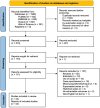Sclerotherapy for hemorrhoidal disease: systematic review and meta-analysis
- PMID: 38261136
- PMCID: PMC10806988
- DOI: 10.1007/s10151-023-02908-w
Sclerotherapy for hemorrhoidal disease: systematic review and meta-analysis
Abstract
Background: This systematic review and meta-analysis aimed to evaluate the safety and efficacy of sclerotherapy methods for hemorrhoidal disease (HD) over the past 40 years.
Methods: The review followed the 2020 Preferred Reporting Items for Systematic Reviews and Meta-analyses (PRISMA) guidelines. A comprehensive literature search was conducted, including studies reporting the use of sclerotherapy in patients with HD. Study eligibility criteria were defined, and data were extracted independently by the authors. Random-effects meta-analyses were performed to assess outcomes of interest.
Results: Out of 1965 records identified, 44 studies met the inclusion criteria, involving 9729 patients. The majority of studies were conducted in Japan, followed by the UK, Italy, and Portugal. The median age of participants was 52 years, and the majority were male. The Goligher grade distribution indicated varying degrees of HD severity. Sclerotherapy was predominantly administered through anoscopy, with polidocanol being the most commonly used agent. The procedure was generally performed without pre-injection analgesia. The meta-analysis of 14 randomized controlled trials (RCTs) revealed that sclerotherapy was not inferior to control interventions in terms of success rate (risk ratio [RR] 1.00, 95% CI 0.71-1.41) and recurrence rate (RR 1.11, 95% CI 0.69-1.77), while resulting in fewer complications (RR 0.46, 95% CI 0.23-0.92).
Conclusions: This systematic review highlights the safety and efficacy of sclerotherapy for HD, which yields similar success rates and fewer complications compared to other conservative or surgical approaches. Further research is warranted to optimize sclerotherapy techniques and evaluate long-term outcomes.
Registration: PROSPERO 2023 CRD42023396910.
Keywords: Hemorrhoidal disease; Meta-analysis; Polidocanol foam; Sclerotherapy; Systematic review.
© 2024. The Author(s).
Conflict of interest statement
The authors declare that they have no conflict of interest.
Figures






References
-
- Johanson JF, Sonnenberg A (1990) The prevalence of hemorrhoids and chronic constipation. An epidemiologic study. Gastroenterology 98:380–386 - PubMed
-
- Riss S, Weiser FA, Schwameis K et al (2012) The prevalence of hemorrhoids in adults. Int J Colorectal Dis 27:215–220 - PubMed
-
- Salgueiro P, Garrido M, Santos RG, Pedroto I, Castro-Pocas FM (2022) Polidocanol foam sclerotherapy versus rubber band ligation in hemorrhoidal disease grades I/II/III: randomized trial. Dis Colon Rectum 65:e718–e727 - PubMed
-
- Davis BR, Lee-Kong SA, Migaly J, Feingold DL, Steele SR (2018) The American Society of Colon and Rectal Surgeons clinical practice guidelines for the management of hemorrhoids. Dis Colon Rectum 61:284–292 - PubMed
Publication types
MeSH terms
Substances
LinkOut - more resources
Full Text Sources
Medical
Miscellaneous

